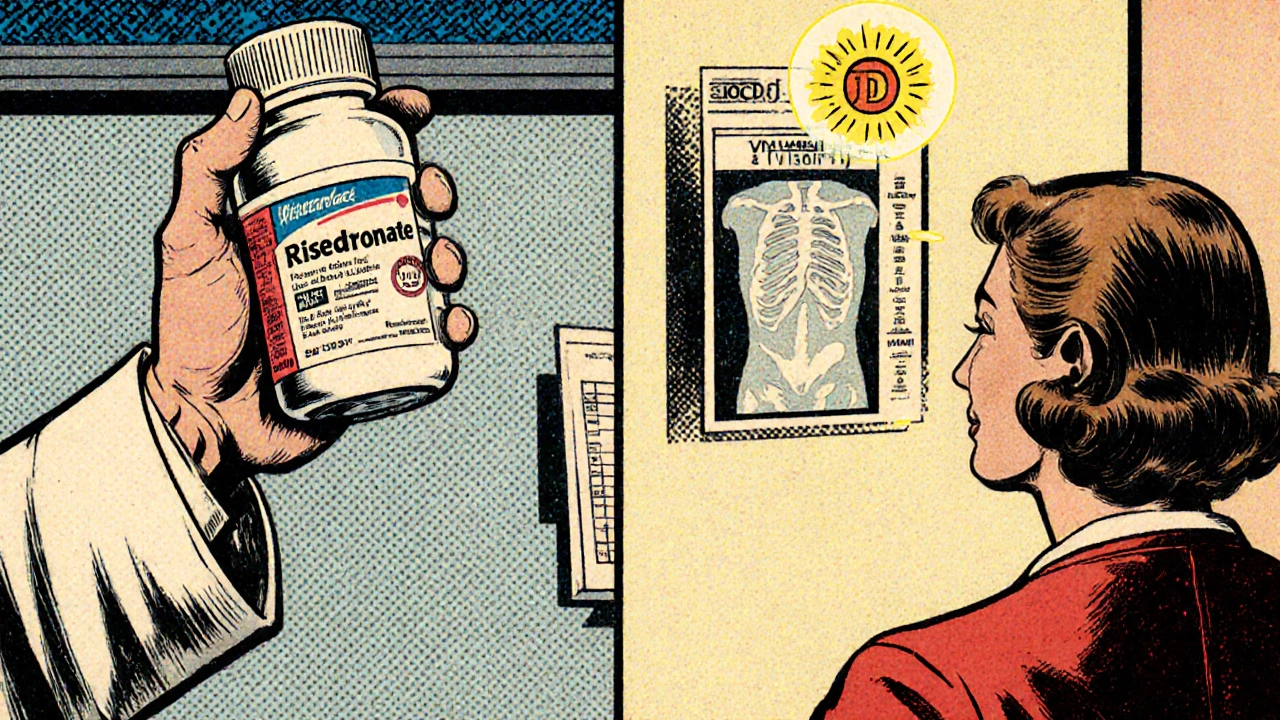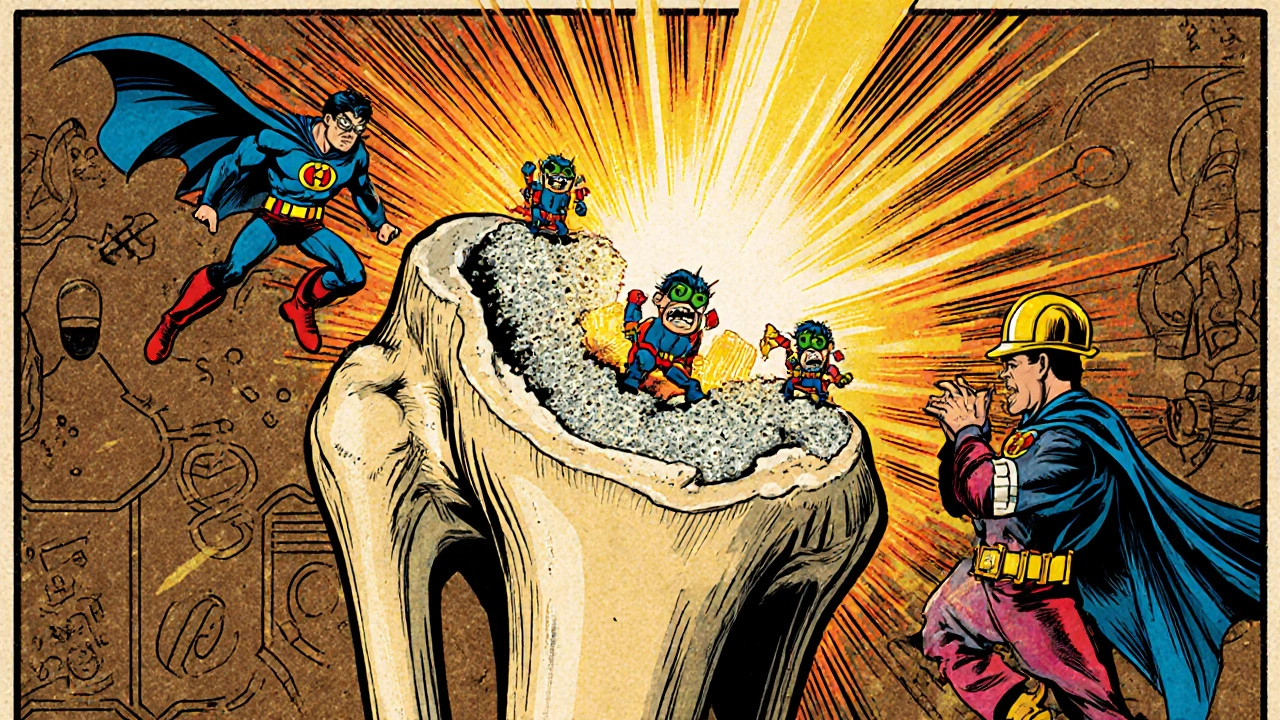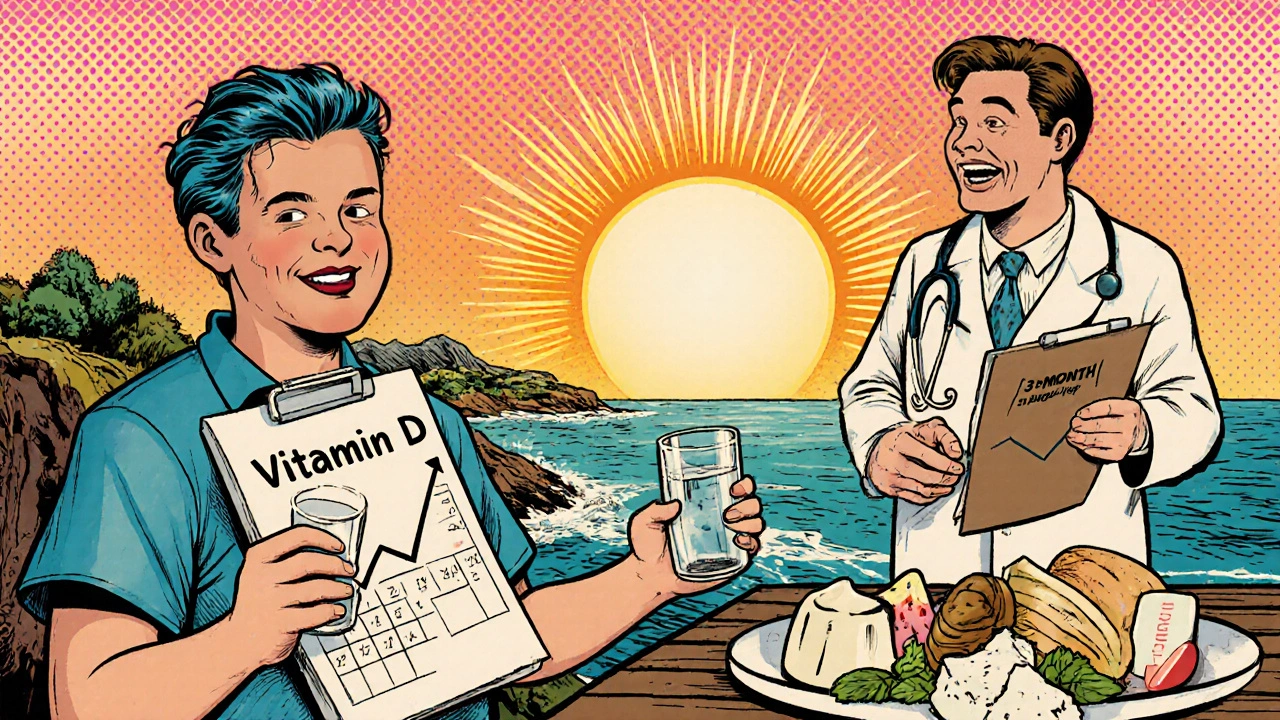Vitamin D’s Role in Risedronate Therapy: Why It Matters

Vitamin D Calculator for Risedronate Therapy
Optimize Your Risedronate Therapy
Enter your serum 25-hydroxy vitamin D level to see how it impacts your bone density gains and fracture risk reduction with Risedronate.
When doctors prescribe Risedronate is a bisphosphonate that slows bone loss and reduces fracture risk in people with osteoporosis. Yet the drug works best when the body has enough Vitamin D is a fat‑soluble vitamin that helps the gut absorb calcium and keeps the calcium‑parathyroid hormone loop in balance. Ignoring that connection can blunt the benefits of Risedronate and leave patients vulnerable to the very fractures the medication is meant to prevent.
Why Vitamin D Matters for Bone Health
Vitamin D does three things that are critical for strong bones:
- Boosts intestinal calcium absorption, letting the diet supply the mineral needed for bone formation.
- Regulates Parathyroid hormone (PTH), keeping it from pulling calcium out of bone when blood levels dip.
- Supports the activity of osteoblasts, the cells that build new bone tissue.
Without adequate Vitamin D, even a calcium‑rich diet can leave the bloodstream starving for calcium, triggering PTH spikes and accelerating bone loss.
How Risedronate Works
Risedronate binds to the mineral surface of bone and interferes with the action of osteoclasts - the cells that break down bone. By slowing resorption, the medication gives osteoblasts a chance to catch up and lay down new bone. The result is a net gain in bone mineral density (BMD) and a lower chance of vertebral or hip fractures.
However, the drug’s ability to halt resorption doesn’t automatically fix a calcium‑deficient environment. That’s why clinicians pair Risedronate with calcium and Vitamin D supplementation.
Evidence Linking Vitamin D Status to Risedronate Success
Several studies published between 2018 and 2024 have measured BMD outcomes in patients taking Risedronate with differing levels of Vitamin D:
- A 2020 double‑blind trial of 1,200 post‑menopausal women found that those with serum 25‑hydroxy‑Vitamin D above 30ng/mL gained an average of 4.2% in lumbar spine BMD, while those below 20ng/mL saw only a 1.1% gain.
- A 2022 meta‑analysis of 15 Risedronate trials reported a 22% lower fracture risk when patients also received 800IU of Vitamin D daily, compared to Risedronate alone.
- Research from the Canadian Osteoporosis Initiative (2023) highlighted that Vitamin D deficiency (<20ng/mL) doubled the odds of gastrointestinal side effects from Risedronate, leading to higher discontinuation rates.
These data make a clear case: adequate Vitamin D isn’t just a nice‑to‑have; it’s a key driver of therapeutic success.

Assessing Vitamin D Levels Before Starting Therapy
Before initiating Risedronate, physicians should order a serum 25‑hydroxy‑Vitamin D test. The commonly accepted thresholds are:
- Deficient: < 20ng/mL - needs aggressive repletion.
- Insufficient: 20-29ng/mL - should be corrected before or alongside Risedronate.
- Sufficient: ≥30ng/mL - optimal for bone health.
If a patient falls into the deficient or insufficient range, a loading regimen (e.g., 50,000IU weekly for 6‑8 weeks) followed by a maintenance dose (800‑1,000IU daily) is recommended.
Practical Supplementation Strategies
Here’s a simple plan that aligns with most osteoporosis guidelines:
- Calcium: 1,200mg/day from diet+supplement if needed, split into two doses.
- Vitamin D: 800-1,000IU/day for maintenance; higher loading doses for deficiency.
- Timing: Take Risedronate first thing in the morning with a full glass of water, then wait at least 30minutes before eating or drinking anything else.
- Monitoring: Re‑check Vitamin D levels after 3 months of supplementation and adjust the dose accordingly.
Patients who enjoy regular sunlight exposure may need lower supplemental doses, but remember that latitude, season, skin pigmentation, and sunscreen use all affect cutaneous Vitamin D synthesis.

Potential Pitfalls and How to Avoid Them
Even with the right doses, a few common errors can undermine therapy:
- Skipping the supplement: Some patients stop Vitamin D once they feel “better.” Reinforce the need for ongoing intake.
- Inadequate calcium: Vitamin D can’t do its job without enough calcium to absorb.
- Taking Risedronate with food: This reduces absorption and may cause esophageal irritation.
- Ignoring drug interactions: Antacids, calcium supplements, and certain antibiotics can interfere with Risedronate if taken within 30minutes.
Address these issues during each follow‑up visit to keep the regimen on track.
Key Takeaways
- Vitamin D is essential for calcium absorption and PTH regulation, both crucial for Risedronate’s effectiveness.
- Patients with serum 25‑hydroxy‑Vitamin D ≥30ng/mL see significantly greater BMD gains and fewer fractures.
- Screen for Vitamin D status before starting Risedronate and correct deficiencies promptly.
- Combine Risedronate with 800‑1,000IU of Vitamin D daily and 1,200mg of calcium for optimal results.
- Monitor levels, adhere to timing rules, and watch for drug‑nutrient interactions.
Frequently Asked Questions
Can I get enough Vitamin D from sunlight alone?
Sunlight can provide most of the needed Vitamin D during summer months at lower latitudes, but factors like skin tone, clothing, sunscreen, and time spent outdoors often limit production. Most clinicians still recommend a daily supplement of at least 800IU, especially in winter or for people living north of the 40th parallel.
What if I have kidney disease? Is Vitamin D still safe?
Chronic kidney disease alters the conversion of Vitamin D to its active form. In those cases, doctors may prescribe active analogs like calcitriol instead of standard cholecalciferol. Always discuss dosing with a nephrologist before starting any supplement.
Do I need to take calcium and Vitamin D together?
Yes. Calcium provides the raw material for bone, while Vitamin D unlocks its absorption. Taking them at the same meal maximizes uptake, but keep the Vitamin D dose separate from the Risedronate dose to avoid interference.
How long should I stay on Risedronate with Vitamin D?
Most guidelines suggest a treatment course of 3-5 years, followed by a drug holiday to reassess fracture risk. Vitamin D supplementation, however, can be lifelong if the individual remains at risk for deficiency.
Can Risedronate cause low Vitamin D levels?
Risedronate itself does not deplete Vitamin D, but patients on bisphosphonates often have low baseline Vitamin D because they share similar risk factors (age, limited sun, poor diet). Regular testing catches these gaps early.
Rosalee Lance
October 16, 2025 AT 14:27When you read about Risedronate you might think the pharma world is just handing out miracle pills, but the truth is veiled in a web of oversight. Vitamin D isn’t just a vitamin; it’s a silent regulator that the industry pretends is optional. If you’re not vigilant, you’ll be feeding the system that keeps you dependent on supplements while it hoards the real cure. The link between bone density and sunlight exposure is something they don’t want you to connect, because it threatens the profit pipeline. Stay aware, question the dosage recommendations, and demand a holistic approach that includes natural sources of Vitamin D.
Kara Lippa
October 17, 2025 AT 12:40Great overview! It’s impressive how the article ties the biochemical pathways together. Adding a reminder about checking serum 25‑hydroxy levels can help readers personalize their supplement plan. Also, a quick note on proper spacing of calcium tablets with meals could prevent absorption issues. Keep up the clear writing!
Puneet Kumar
October 18, 2025 AT 10:54From a clinical pharmacology standpoint, Risedronate’s affinity for hydroxyapatite crystals creates a niche microenvironment that modulates osteoclastogenesis. In populations with prevalent Vitamin D deficiency-such as South Asian cohorts-the pharmacodynamic response can be suboptimal without correcting the endocrine milieu. Therefore, integrating 25‑OH vitamin D assay data into the therapeutic algorithm is not merely adjunctive but imperative. Moreover, the synergistic effect on the RANK–RANKL–OPG axis underscores the necessity of a bi‑modal approach. Practitioners should also consider genetic polymorphisms in CYP2R1 that affect vitamin D activation when tailoring dosages.
michael maynard
October 19, 2025 AT 09:07Honestly, most of these “studies” sound like corporate PR fluff. They cherry‑pick data to sell you more pills while ignoring the real cause-lack of sunlight and poor diet. Don’t be fooled into thinking a tablet will fix everything.
Roger Bernat Escolà
October 20, 2025 AT 07:20The thing about bone health is that it's a slow burn, and we often feel powerless while the risk of fractures looms. It’s heartbreaking to see seniors suffer because of missed supplementation. Keeping Vitamin D levels optimal feels like a small victory in a big battle.
Allison Metzner
October 21, 2025 AT 05:34Exactly, Roger. The emotional toll of constantly fearing a break is often understated, and the simple act of correcting a Vitamin D deficiency can restore a sense of control.
Rajashree Varma
October 22, 2025 AT 03:47Vitamin D acts as a bridge between the skeletal framework and the body’s internal harmony. When that bridge is weak, the entire structure shakes. Supplementation, when done responsibly, can restore balance without overcomplicating the regimen. It’s a gentle reminder that health isn’t just about medication but about restoring natural equilibrium. Let’s keep the conversation calm and focused on practical steps.
Anshuman Pandey
October 23, 2025 AT 02:00From a holistic perspective, the interplay of Risedronate and Vitamin D exemplifies synergy in therapeutic design. The bisphosphonate halts resorption while the vitamin ensures mineral availability for new formation. Think of it as a two‑person crew: one stops the leak, the other supplies the building blocks. Patients who attend regular monitoring appointments tend to see better outcomes, reinforcing the importance of adherence. Embracing this dual approach can empower individuals to take charge of their bone health.
Thomas Malloy
October 24, 2025 AT 00:14Bottom line: get enough sunshine.
Sushma Gowda
October 24, 2025 AT 22:27It’s easy to overlook how Vitamin D status modifies drug efficacy, but a quick blood test can save months of ineffective treatment. Think of it as a checkpoint before you load the next round of medication. Also, pairing calcium carbonate with meals can enhance absorption and reduce gastrointestinal discomfort. Stay consistent, and you’ll likely see incremental gains in bone density.
Angie Wallace
October 25, 2025 AT 20:40Vitamin D supplementation is a simple step that can dramatically improve Risedronate results. Consistency is key and checking levels every six months helps keep you on track. Don’t forget to take calcium with food.
Doris Montgomery
October 26, 2025 AT 17:54This article reads like a rehash of textbook material with no new insight. It’s fine for beginners but seasoned clinicians will find it redundant. A deeper dive into dosage optimization would have been appreciated.
Nick Gulliver
October 27, 2025 AT 16:07Honestly, I’m tired of seeing health advice wrapped in political correctness. Real bone health comes from strong, traditional values and hard work.
Sadie Viner
October 28, 2025 AT 14:20Thank you for the comprehensive synthesis of the recent literature. The inclusion of the 2022 meta‑analysis provides robust evidence for the additive benefit of Vitamin D. Clinicians should note the threshold serum 25‑hydroxy level of 30 ng/mL as a target for optimal response. Additionally, patient education on the timing of calcium and Vitamin D intake can mitigate gastrointestinal side effects. Implementing these practical recommendations will likely enhance therapeutic outcomes in osteoporosis management.
Kristen Moss
October 29, 2025 AT 12:34Look, if you want strong bones you better stop whining and start taking your supplements like a real American.
Rachael Tanner
October 30, 2025 AT 10:47Vitamin D’s role in osteoporotic therapy is often dramatized, yet the biochemistry is elegantly straightforward. When sunlight photons trigger cutaneous synthesis, cholecalciferol undergoes hepatic 25‑hydroxylation, producing the circulating precursor that clinicians measure. Without sufficient 25‑hydroxyvitamin D, the intestinal calcium transporters remain under‑expressed, sabotaging the very substrate Risedronate protects. Moreover, low vitamin D levels provoke secondary hyperparathyroidism, which accelerates bone turnover and blunts the bisphosphonate’s anti‑resorptive effect. A meta‑analysis from 2022 quantifies a 22 % reduction in fracture incidence when patients sustain serum levels above 30 ng/mL, a statistic that cannot be ignored. It is also noteworthy that genetic polymorphisms in the vitamin D receptor modulate individual responsiveness, adding a layer of personalized medicine to the equation. The interplay between RANKL inhibition by Risedronate and vitamin D–mediated osteoblast activation creates a synergistic environment conducive to net bone accrual. Clinicians should therefore adopt a dual‑pronged protocol: verify baseline vitamin D status, correct deficiencies with an appropriate loading regimen, and maintain supplementation throughout bisphosphonate therapy. Failure to do so not only wastes pharmaceutical resources but also jeopardizes patient safety, increasing the risk of atypical fractures. In practice, a loading phase of 50,000 IU weekly for eight weeks, followed by a maintenance dose of 800–1,000 IU daily, has been shown to normalize serum levels in most adults. Concurrently, calcium intake of 1,200 mg per day, preferably from dietary sources, maximizes mineral availability for bone remodeling. While the cost of high‑dose vitamin D may raise eyebrows, the downstream savings from avoided fractures are substantial. Patients should be counseled on the importance of adherence, as intermittent dosing can lead to fluctuating serum concentrations and reduced efficacy. Finally, ongoing research into vitamin D analogs promises even greater potency with fewer hypercalcemia concerns, hinting at future therapeutic horizons. In sum, vitamin D is not an optional garnish but a foundational pillar supporting the edifice of Risedronate therapy.